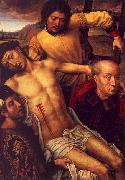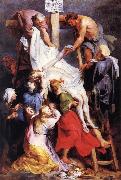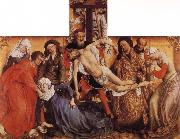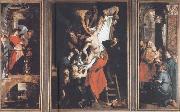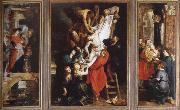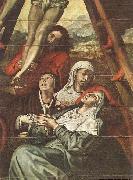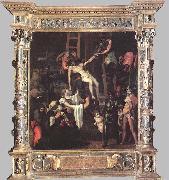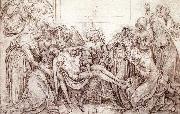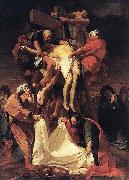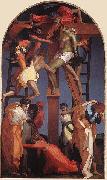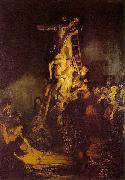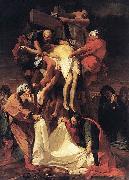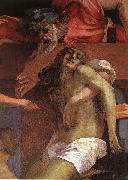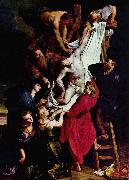Wholesale Oil Painting No Minimum |
|||||||||||
|
|
|||||||||||

|
|||||||||||
|
|
|
||||||||
Hans MemlingNetherlandish Northern Renaissance Painter, ca.1435-1494 Born in Seligenstadt, near Frankfurt in the Middle Rhein region, it is believed that Memling served his apprenticeship at Mainz or Cologne, and later worked in the Netherlands under Rogier van der Weyden (c. 1455?C1460). He then went to Bruges around 1465. There is an apocryphical story that he was a wounded at the Battle of Nancy, sheltered and cured by the Hospitallers at Bruges, and that to show his gratitude he refused payment for a picture he had painted for them. Memling did indeed paint for the Hospitallers, but he painted several pictures for them, in 1479 and 1480, and it is likely that he was known to his patrons of St John, prior to the Battle of Nancy. Memling is connected with military operations only in a distant sense. His name appears on a list of subscribers to the loan which was raised by Maximilian I of Austria, to defend against hostilities towards France in 1480. In 1477, when he was incorrectly claimed to have been killed, he was under contract to create an altarpiece for the gild-chapel of the booksellers of Bruges. This altarpiece, under the name of the Seven Griefs of Mary, is now in the Gallery of Turin. It is one of the fine creations of his more mature period. It is not inferior in any way to those of 1479 in the hospital of St. John, which for their part are hardly less interesting as illustrative of the master's power than The Last Judgment which can be found since the 1470s in the St. Mary's Church, Gda??sk. Critical opinion has been unanimous in assigning this altarpiece to Memling. This affirms that Memling was a resident and a skilled artist at Bruges in 1473; for the Last Judgment was undoubtedly painted and sold to a merchant at Bruges, who shipped it there on board of a vessel bound to the Mediterranean, which was captured by Danzig privateer Paul Beneke in that very year. This purchase of his pictures by an agent of the Medici demonstrates that he had a considerable reputation. |
||||||||
|
|
||||||||
Descent from the Cross
Descent from the Cross Painting ID:: 2918 |
1480/90
Capilla Real, Granada 1480/90 Capilla Real, Granada |
|||||||
|
|
||||||||
RUBENS, Pieter PauwelFlemish Baroque Era Painter, 1577-1640 |
||||||||
|
|
||||||||
|
|
Descent from the Cross
Descent from the Cross Painting ID:: 29664 |
1616-17
Oil on canvas, 425 x 295 cm 1616-17 Oil on canvas, 425 x 295 cm |
||||||
|
|
||||||||
Rogier van der WeydenRogier van der Weyden 1399/1400 - 1464 was the most important representative of Netherlandish painting or Northern Renaissance ... is, with Jan van Eyck, considered one of the greatest exponents of the school of Early Netherlandish painting. Rogier van der Weyden was born in Tournai as 'Rogier de le Pasture' (Roger of the Pasture) in 1399 or 1400. His parents were Henri de le Pasture and Agnes de Watr??los. The family had settled before in the city of Tournai where Rogiers father worked as a 'maître-coutelier' (knife manufacturer). In 1426 Rogier married Elisabeth, the daughter of the Brussels shoemaker Jan Goffaert and his wife Cathelyne van Stockem. Rogier and Elisabeth had four children: Cornelius, who became a Carthusian monk, was born in 1427, a daughter Margaretha in 1432. Before 21 October 1435 the family settled in Brussels where the two younger children were born: Pieter in 1437 and Jan the next year. From the second of March 1436 onwards held the title of 'painter to the town of Brussels' (stadsschilder) a very prestigious post because Brussels was at that time the most important residence of the splendid court of the Dukes of Burgundy. It was at the occasion of his move to the Dutch-speaking town of Brussels that Rogier began using the Dutch version of his name: 'Rogier van der Weyden'Little is known about Rogier's training as a painter. The archival sources from Tournai (completely destroyed during World War II, but luckily partly transcribed in the 19th and early 20th century) are somewhat confusing and have led to different interpretations by scholars. From a document it is known that the city council of Tournai offered wine in honour of a certain 'Maistre Rogier de le Pasture' on March the 17th 1427. However, on the 5th of March of the following year the records of the painters' guild show a certain 'Rogelet de le Pasture' entered the workshop of Robert Campin together with Jacques Daret. Only five years later, on the first of August 1432, Rogier de le Pasture obtains the title of 'Master' (Maistre) as a painter.[1] Many have doubted whether Campin's apprentice 'Rogelet' was the same as the master 'Rogier' that was offered the wine back in 1426. The fact that in 1426-1427 Rogier was a married man in his late twenties, and well over the normal age of apprenticeship has been used as an argument to consider 'Rogelet' as a younger painter with the same name. In the 1420's however the city of Tournai was in crisis and as a result the guilds were not functioning normally. The late apprenticeship of Rogier/Rogelet may have been a legal formality. Also Jacques Daret was then in his twenties and had been living and working in Campin's household for at least a decade. It is possible that Rogier obtained an academic title (Master) before he became a painter and that he was awarded the wine of honour on the occasion of his graduation. The sophisticated and 'learned' iconographical and compositional qualities of the paintings attributed to him are sometimes used as an argument in favour of this supposition. The social and intellectual status of Rogier in his later life surpassed that of a mere craftsman at that time. In general the close stylistical link between the documented works of Jacques Daret, and the paintings attributed to Robert Campin and Rogier van der Weyden is considered as the main argument to consider Rogier van der Weyden as a pupil of Robert Campin. The last mention of Rogier de la Pasture in the financial records of Tournai, on October 21, 1435, lists him as demeurrant ?? Brouxielles ('living in Brussels'). At the same time, the first mention of Rogier de Weyden is made as the official painter of Brussels. Therefore Rogier de la Pasture and Rogier Van der Weyden are thought to be one and the same painter. The post of city painter was created especially for Van der Weyden and was meant to lapse on his death. It was linked to a huge commission to paint four justice scenes for the 'Golden Chamber' of Brussels City Hall.[2] Different properties and investments are documented and witness his material prosperity. The portraits he painted of the Burgundian Dukes, their relatives and courtiers, demonstrate a close relationship with the elite of the Netherlands. The Miraflores Altarpiece was probably commissioned by King Juan II of Castile, since Juan II donated it to the monastery of Miraflores in 1445. |
||||||||
|
|
||||||||
|
|
Descent from the Cross
Descent from the Cross Painting ID:: 33429 |
mk86
c.1435-1440
Tempera on wood
220x262cm
Madrid,Museo del Prado
mk86 c.1435-1440 Tempera on wood 220x262cm Madrid,Museo del Prado |
||||||
|
|
||||||||
Francesco Solimena1657-1747 Italian Francesco Solimena Gallery Francesco Solimena was born in Canale di Serino, near Avellino. He received early training from his father, Angelo Solimena, with whom he executed a Paradise for the cathedral of Nocera (place where he spend a big part of his life) and a Vision of St. Cyril of Alexandria for the church of San Domenico at Solofra. He settled in Naples in 1674, there he worked in the studio of Francesco di Maria and later Giacomo del Po[1]. He apparently had taken the clerical orders, but was patronized early on, and encouraged to become an artist by Cardinal Vincenzo Orsini (later Pope Benedict XIII)[2]. By the 1680s, he had independent fresco commissions, and his active studio came to dominate Neapolitan painting from the 1690s through the first four decades of the 18th century. He modeled his art??for he was a highly conventional painter??after the Roman Baroque masters, Luca Giordano and Giovanni Lanfranco, and Mattia Preti, whose technique of warm brownish shadowing Solimena emulated. Solimena painted many frescoes in Naples, altarpieces, celebrations of weddings and courtly occasions, mythological subjects, characteristically chosen for their theatrical drama, and portraits. His settings are suggested with a few details??steps, archways, balustrades, columns??concentrating attention on figures and their draperies, caught in pools and shafts of light. Art historians take pleasure in identifying the models he imitated or adapted in his compositions. His numerous preparatory drawings often mix media, combining pen-and-ink, chalk and watercolor washes. Francesco Solimena 'A study for the fresco cycle in the Sacristy of San Paolo Maggiore in Naples', Whitfield Fine Art.A typical example of the elaborately constructed allegorical "machines" of his early mature style, fully employing his mastery of chiaroscuro, is the Allegory of Rule (1690) from the Stroganoff collection, which has come to the State Hermitage Museum, St Petersburg. He apparently hoped to see his son Orazio follow a career in the law, for which he received a doctorate (de Domenici), but also became a painter. His large, efficiently structured atelier became a virtual academy, at the heart of cultural life in Naples. Among his many pupils were Francesco de Mura (1696-1784) , Giuseppe Bonito (1707-89), Pietro Capelli, Gaspare Traversi, and most notably Corrado Giaquinto and Sebastiano Conca. The Scottish portraitist Allan Ramsay spent three years in Solimena's studio. Solimena amassed a fortune, was made a baron and lived in sumptuous style founded on his success. Francesco Solimena died at Barra, near Naples, in 1747. |
||||||||
|
|
||||||||
|
|
Descent from the Cross
Descent from the Cross Painting ID:: 39633 |
mk150
c.1730/31
Canvas
398x223cm
mk150 c.1730/31 Canvas 398x223cm |
||||||
|
|
||||||||
Peter Paul RubensFlemish Baroque Era Painter, 1577-1640 Peter Paul Rubens (June 28, 1577 ?C May 30, 1640) was a prolific seventeenth-century Flemish Baroque painter, and a proponent of an exuberant Baroque style that emphasized movement, color, and sensuality. He is well-known for his Counter-Reformation altarpieces, portraits, landscapes, and history paintings of mythological and allegorical subjects. In addition to running a large studio in Antwerp which produced paintings popular with nobility and art collectors throughout Europe, Rubens was a classically-educated humanist scholar, art collector, and diplomat who was knighted by both Philip IV, king of Spain, and Charles I, king of England. Rubens was a prolific artist. His commissioned works were mostly religious subjects, "history" paintings, which included mythological subjects, and hunt scenes. He painted portraits, especially of friends, and self-portraits, and in later life painted several landscapes. Rubens designed tapestries and prints, as well as his own house. He also oversaw the ephemeral decorations of the Joyous Entry into Antwerp by the Cardinal-Infante Ferdinand in 1635. His drawings are mostly extremely forceful but not detailed; he also made great use of oil sketches as preparatory studies. He was one of the last major artists to make consistent use of wooden panels as a support medium, even for very large works, but he used canvas as well, especially when the work needed to be sent a long distance. For altarpieces he sometimes painted on slate to reduce reflection problems. His fondness of painting full-figured women gave rise to the terms 'Rubensian' or 'Rubenesque' for plus-sized women. The term 'Rubensiaans' is also commonly used in Dutch to denote such women. |
||||||||
|
|
||||||||
|
|
Descent from the Cross
Descent from the Cross Painting ID:: 40408 |
mk156
1610-11
Oil on canvas
460x340cm
mk156 1610-11 Oil on canvas 460x340cm |
||||||
|
|
||||||||
Peter Paul RubensFlemish Baroque Era Painter, 1577-1640 Peter Paul Rubens (June 28, 1577 ?C May 30, 1640) was a prolific seventeenth-century Flemish Baroque painter, and a proponent of an exuberant Baroque style that emphasized movement, color, and sensuality. He is well-known for his Counter-Reformation altarpieces, portraits, landscapes, and history paintings of mythological and allegorical subjects. In addition to running a large studio in Antwerp which produced paintings popular with nobility and art collectors throughout Europe, Rubens was a classically-educated humanist scholar, art collector, and diplomat who was knighted by both Philip IV, king of Spain, and Charles I, king of England. Rubens was a prolific artist. His commissioned works were mostly religious subjects, "history" paintings, which included mythological subjects, and hunt scenes. He painted portraits, especially of friends, and self-portraits, and in later life painted several landscapes. Rubens designed tapestries and prints, as well as his own house. He also oversaw the ephemeral decorations of the Joyous Entry into Antwerp by the Cardinal-Infante Ferdinand in 1635. His drawings are mostly extremely forceful but not detailed; he also made great use of oil sketches as preparatory studies. He was one of the last major artists to make consistent use of wooden panels as a support medium, even for very large works, but he used canvas as well, especially when the work needed to be sent a long distance. For altarpieces he sometimes painted on slate to reduce reflection problems. His fondness of painting full-figured women gave rise to the terms 'Rubensian' or 'Rubenesque' for plus-sized women. The term 'Rubensiaans' is also commonly used in Dutch to denote such women. |
||||||||
|
|
||||||||
|
|
descent from the cross
descent from the cross Painting ID:: 56048 |
mk247
1611 to 14 oil on wood 165x182 in,421x464 cm,cathedral of our lady,antwerp,belgium mk247 1611 to 14 oil on wood 165x182 in,421x464 cm,cathedral of our lady,antwerp,belgium |
||||||
|
|
||||||||
Pedro SanchezSpanish Early Renaissance Painter, active ca.1454-1468 |
||||||||
|
|
||||||||
|
|
Descent from the Cross
Descent from the Cross Painting ID:: 62362 |
320 x 191 cm (entire painting) Cathedral, Seville In Seville, the second third of the sixteenth century also witnessed the introduction of a style of painting that reflected the ascendancy of Raphael. In this center, the most important artist of the period were undoubtedly of Northern origin: the Dutchman Fernando Esturmio (Storm), and the Fleming Pedro de Campa?a (Kempeneer). The latter, the more gifted of the two, was born in Brussels in 1503. He was trained in Italy, but in 1537 he is known to have been employed in the Cathedral of Seville. Shortly before 1563 he returned to his native country. The style of this master includes elements derived from Michelangelo, but these are offset by original plastic qualities and a sense of drama. One of Campa?a's key works is the Descent from the Cross (1547) in Seville cathedral, a painting that anticipates the Baroque of Rubens and was much admired by other Spanish artists, particularly Murillo. Campa?a had a more amiable and genuinely Raphaelesque side, evident in the altarpiece of the Marshal's Chapel in Seville cathedral, which he was commissioned to paint in 1555. His progress toward the Baroque and his interest in the rendering of light are revealed in his admirable Adoration of the Magi, which was painted in 1557 320 x 191 cm (entire painting) Cathedral, Seville In Seville, the second third of the sixteenth century also witnessed the introduction of a style of painting that reflected the ascendancy of Raphael. In this center, the most important artist of the period were undoubtedly of Northern origin: the Dutchman Fernando Esturmio (Storm), and the Fleming Pedro de Campa?a (Kempeneer). The latter, the more gifted of the two, was born in Brussels in 1503. He was trained in Italy, but in 1537 he is known to have been employed in the Cathedral of Seville. Shortly before 1563 he returned to his native country. The style of this master includes elements derived from Michelangelo, but these are offset by original plastic qualities and a sense of drama. One of Campa?a's key works is the Descent from the Cross (1547) in Seville cathedral, a painting that anticipates the Baroque of Rubens and was much admired by other Spanish artists, particularly Murillo. Campa?a had a more amiable and genuinely Raphaelesque side, evident in the altarpiece of the Marshal's Chapel in Seville cathedral, which he was commissioned to paint in 1555. His progress toward the Baroque and his interest in the rendering of light are revealed in his admirable Adoration of the Magi, which was painted in 1557 |
||||||
|
|
||||||||
Machuca, PedroSpanish, approx. 1490-1550 Spanish painter and architect. The form of his signature (Petrus Machuca, Hispanus. Toletanus ...) on his earliest known work, the Virgin of Succour (1517; Madrid, Prado), suggests he was active at an early age in Italy. On the basis of the style of that work, a number of frescoes in the Vatican have been attributed to him, including Isaiah Blessing Jacob. Other works from the same period that have been attributed to him include a copy (Paris, Louvre) of the destroyed Battle of Anghiari by Leonardo da Vinci and two paintings of the Virgin and Child |
||||||||
|
|
||||||||
|
|
Descent from the Cross
Descent from the Cross Painting ID:: 62363 |
141 x 128 cm (incl. frame) Museo del Prado, Madrid Machuca was an extraordinary artist, an architect, sculptor and painter. He built the palace of Charles V in Granada, a work of exceptional quality, one of the very few existing Renaissance buildings with a circular court. His training as an architect is evident in the design of the original ornamented frame of this painting with plenty of decorative elements typical of the architecture of first Spanish Renaissance or Plateresque style. It is indicated on this frame that the altarpiece was ordered by Do?a In?s de Castillo, and it was finished in 1547 141 x 128 cm (incl. frame) Museo del Prado, Madrid Machuca was an extraordinary artist, an architect, sculptor and painter. He built the palace of Charles V in Granada, a work of exceptional quality, one of the very few existing Renaissance buildings with a circular court. His training as an architect is evident in the design of the original ornamented frame of this painting with plenty of decorative elements typical of the architecture of first Spanish Renaissance or Plateresque style. It is indicated on this frame that the altarpiece was ordered by Do?a In?s de Castillo, and it was finished in 1547 |
||||||
|
|
||||||||
WEYDEN, Rogier van derNetherlandish Northern Renaissance Painter, ca.1400-1464 major early Flemish master, known also as Roger de la Pasture. He is believed to have studied with Robert Campin. His early works also show the influence of Jan van Eyck. Van Eyck, however, had been a master at objective rendering of detail, whereas Roger in his work portrayed emotions with an assurance that has not been surpassed. His ability to depict piety is reflected in the early masterpiece Descent from the Cross (c.1435; Prado); he depicted with significant restraint the profound grief of the mourners grouped around the tragic figure of Jesus. His composition strongly affected later representations of the theme. Roger became City Painter in Brussels in 1436. He then produced a series of undated altarpieces including the Last Judgment (hospital, Beaune), the Braque Triptych (Louvre), Crucifixion with Donors (Vienna), and Adoration of the Magi (Berlin), which vary in execution from a stress on sumptuous details to a more sculptural rendering of the figures. Roger is believed to have made a pilgrimage to Italy in the holy year 1450. Whether this supposed excursion had any effect on his style is much debated. It has been shown that his Entombment (Uffizi) bears an affinity to the Tuscan treatment of the subject, particularly by Fra Angelico, and that Roger's Virgin and Child with Saints (Frankfurt) has a strong resemblance to the Italian religious art of the day. His style is, however, highly individual. His religious paintings and his portraits are characterized by a straightforward monumentality. The portraits, such as that of a young lady (National Gall. of Art, Washington, D.C.) and of Francesco d'Este (Metropolitan Mus.) exhibit a simple clarity of contour and psychological penetration. Other notable works are his St. Luke Painting the Virgin, of which a version or replica is in the Museum of Fine Arts, Boston, the Crucifixion |
||||||||
|
|
||||||||
|
|
Descent from the Cross
Descent from the Cross Painting ID:: 63879 |
1460 Pen over chalk drawing on paper, 240 x 357 mm Mus?e du Louvre, Paris Paintings in the style of Rogier van der Weyden that are no longer extant are also recorded in several drawings not from the workshop of the Brussels town painter. Among the most notable is this Descent from the Cross, frequently said to derive from an original by Rogier himself, and sometimes even ascribed to Robert Campin. Surrounded by Christ's mourning friends, Joseph of Arimathea and Nicodemus are carrying the body just taken down from the Cross to the tomb. The very unusual outer area, with raised sections at the sides where angels hover with the nails and the crown of thorns, may refer to the place where the painting connected with this drawing was installed - perhaps it was to be placed below a tall window. The composition obviously appealed to contemporary taste, and was copied in painting and sculpture several times. It shares important elements with Rogier's most influential work, the Deposition (Prado, Madrid): there are considerable similarities in the construction of the scene, which again is transferred to an altar shrine, and in some of the figures, particularly those of the bearded Joseph of Arimathea and Mary Magdalene. The Virgin Mary and the flying angels, on the other hand, are more like the corresponding figures in the Crucifixion Triptych (Kunsthistorisches Museum, Vienna), and the figure of St John resembles his counterpart in the Seven Sacraments Altarpiece (Museum of Fine Arts, Antwerp). However, while in a work like the St Columba Altarpiece (Alte Pinakothek, Munich) the figures, taken from various different pre-existing models, are merged into a meaningful whole, there are discrepancies in the Descent from the Cross. Joseph of Arimathea seems to be standing still as he holds the corpse, but the legs of Nicodemus suggest that he is walking away, an action that clashes with the Virgin's heartfelt embrace of Christ. And the Magdalene is obviously shown twice, as the woman with the vessel of ointment - the saint's attribute - standing on the extreme right, veiled as in the Crucifixion Triptych, and as the figure of the Magdalene from the Deposition, identifiable as the former sinner by her low-cut, expensive dress. These inconsistencies cannot be reconciled with Rogier's careful, confident style, and the drawing cannot therefore be considered a copy from a work conceived by him. In fact it is not yet clear whether it is a copy at all, or whether it may be a sketch for a design.Artist:WEYDEN, Rogier van der Title: Descent from the Cross Painted in 1401-1450 , Flemish - - graphics : study 1460 Pen over chalk drawing on paper, 240 x 357 mm Mus?e du Louvre, Paris Paintings in the style of Rogier van der Weyden that are no longer extant are also recorded in several drawings not from the workshop of the Brussels town painter. Among the most notable is this Descent from the Cross, frequently said to derive from an original by Rogier himself, and sometimes even ascribed to Robert Campin. Surrounded by Christ's mourning friends, Joseph of Arimathea and Nicodemus are carrying the body just taken down from the Cross to the tomb. The very unusual outer area, with raised sections at the sides where angels hover with the nails and the crown of thorns, may refer to the place where the painting connected with this drawing was installed - perhaps it was to be placed below a tall window. The composition obviously appealed to contemporary taste, and was copied in painting and sculpture several times. It shares important elements with Rogier's most influential work, the Deposition (Prado, Madrid): there are considerable similarities in the construction of the scene, which again is transferred to an altar shrine, and in some of the figures, particularly those of the bearded Joseph of Arimathea and Mary Magdalene. The Virgin Mary and the flying angels, on the other hand, are more like the corresponding figures in the Crucifixion Triptych (Kunsthistorisches Museum, Vienna), and the figure of St John resembles his counterpart in the Seven Sacraments Altarpiece (Museum of Fine Arts, Antwerp). However, while in a work like the St Columba Altarpiece (Alte Pinakothek, Munich) the figures, taken from various different pre-existing models, are merged into a meaningful whole, there are discrepancies in the Descent from the Cross. Joseph of Arimathea seems to be standing still as he holds the corpse, but the legs of Nicodemus suggest that he is walking away, an action that clashes with the Virgin's heartfelt embrace of Christ. And the Magdalene is obviously shown twice, as the woman with the vessel of ointment - the saint's attribute - standing on the extreme right, veiled as in the Crucifixion Triptych, and as the figure of the Magdalene from the Deposition, identifiable as the former sinner by her low-cut, expensive dress. These inconsistencies cannot be reconciled with Rogier's careful, confident style, and the drawing cannot therefore be considered a copy from a work conceived by him. In fact it is not yet clear whether it is a copy at all, or whether it may be a sketch for a design.Artist:WEYDEN, Rogier van der Title: Descent from the Cross Painted in 1401-1450 , Flemish - - graphics : study |
||||||
|
|
||||||||
RUBENS, Pieter PauwelFlemish Baroque Era Painter, 1577-1640 |
||||||||
|
|
||||||||
|
|
Descent from the Cross
Descent from the Cross Painting ID:: 64196 |
1612-14 Oil on panel, 421 x 153 cm O.-L. Vrouwekathedraal, Antwerp The outsides of the wings are devoted to St Christopher. According to his medieval legend, the huge St Christopher carried the Christ Child across a river on his shoulders. A hermit on the right lights his way with a lantern. , Artist: RUBENS, Pieter Pauwel , Descent from the Cross (outside left) , 1601-1650 , Flemish , painting , religious 1612-14 Oil on panel, 421 x 153 cm O.-L. Vrouwekathedraal, Antwerp The outsides of the wings are devoted to St Christopher. According to his medieval legend, the huge St Christopher carried the Christ Child across a river on his shoulders. A hermit on the right lights his way with a lantern. , Artist: RUBENS, Pieter Pauwel , Descent from the Cross (outside left) , 1601-1650 , Flemish , painting , religious |
||||||
|
|
||||||||
RUBENS, Pieter PauwelFlemish Baroque Era Painter, 1577-1640 |
||||||||
|
|
||||||||
|
|
Descent from the Cross
Descent from the Cross Painting ID:: 64197 |
1612-14 Oil on panel, 421 x 153 cm O.-L. Vrouwekathedraal, Antwerp The right wing of the great triptych of the Descent from the Cross is devoted to the presentation of the Infant Christ in the Temple at Jerusalem. The elderly Simeon holds the Child in his arms while the prophetess Anna, located in the shadows between Simeon and Mary, looks on joyfully. Joseph, who has brought two sacrificial doves with him, kneels down respectfully. The onlooker on the left edge of this splendid temple interior is Nicolaas Rockox, a friend of Rubens and a prominent figure in Antwerp. , Artist: RUBENS, Pieter Pauwel , Descent from the Cross (right wing) , 1601-1650 , Flemish , painting , religious 1612-14 Oil on panel, 421 x 153 cm O.-L. Vrouwekathedraal, Antwerp The right wing of the great triptych of the Descent from the Cross is devoted to the presentation of the Infant Christ in the Temple at Jerusalem. The elderly Simeon holds the Child in his arms while the prophetess Anna, located in the shadows between Simeon and Mary, looks on joyfully. Joseph, who has brought two sacrificial doves with him, kneels down respectfully. The onlooker on the left edge of this splendid temple interior is Nicolaas Rockox, a friend of Rubens and a prominent figure in Antwerp. , Artist: RUBENS, Pieter Pauwel , Descent from the Cross (right wing) , 1601-1650 , Flemish , painting , religious |
||||||
|
|
||||||||
RUBENS, Pieter PauwelFlemish Baroque Era Painter, 1577-1640 |
||||||||
|
|
||||||||
|
|
Descent from the Cross
Descent from the Cross Painting ID:: 64198 |
1612-14 Oil on panel, 421 x 153 cm O.-L. Vrouwekathedraal, Antwerp The outsides of the wings are devoted to St Christopher. According to his medieval legend, the huge St Christopher carried the Christ Child across a river on his shoulders. A hermit on the right lights his way with a lantern. , Artist: RUBENS, Pieter Pauwel , Descent from the Cross (outside right) , 1601-1650 , Flemish , painting , religious 1612-14 Oil on panel, 421 x 153 cm O.-L. Vrouwekathedraal, Antwerp The outsides of the wings are devoted to St Christopher. According to his medieval legend, the huge St Christopher carried the Christ Child across a river on his shoulders. A hermit on the right lights his way with a lantern. , Artist: RUBENS, Pieter Pauwel , Descent from the Cross (outside right) , 1601-1650 , Flemish , painting , religious |
||||||
|
|
||||||||
Jean-Baptiste Jouvenet1644-1717 French Jean Baptiste Jouvenet Galleries He came from an artistic family, one of whom Noel Jouvenet may have taught Nicolas Poussin. He early showed remarkable aptitude for his profession, and, on arriving in Paris, attracted the attention of Le Brun, by whom he was employed at Versailles, and under whose auspices, in 1675, he became a member of the Acad??mie royale, of which he was elected professor in 1681, and one of the four perpetual rectors in 1707. He also worked under Charles de la Fosse in the Invalides and Trianon. The great mass of works that he executed, chiefly in Paris, many of which, including his celebrated Miraculous Draught of Fishes (engraved by Audran; also Landon, Annales, i. 42), are now in the Louvre, show his fertility in invention and execution, and also that he possessed in a high degree that general dignity of arrangement and style which distinguished the school of Le Brun. Jouvenet died on the 5 April 1717, having been forced by paralysis during the last four years of his life to work with his left hand. |
||||||||
|
|
||||||||
|
|
Descent from the Cross
Descent from the Cross Painting ID:: 85646 |
Date 1697(1697)
Medium Oil on canvas
Dimensions 424 x 312 cm (166.9 x 122.8 in)
cjr Date 1697(1697) Medium Oil on canvas Dimensions 424 x 312 cm (166.9 x 122.8 in) cjr |
||||||
|
|
||||||||
Rosso FiorentinoItalian Mannerist Painter, ca.1495-1540 Born in Florence Italy with the red hair that gave him his nickname, Rosso first trained in the studio of Andrea del Sarto alongside his contemporary, Pontormo. In late 1523, Rosso moved to Rome, where he was exposed to the works of Michelangelo, Raphael, and other Renaissance artists, resulting in the realignment of his artistic style. Fleeing Rome after the Sacking of 1527, Rosso eventually went to France where he secured a position at the court of Francis I in 1530, remaining there until his death. Together with Francesco Primaticcio, Rosso was one of the leading artists to work at the Chateau Fontainebleau as part of the "First School of Fontainebleau", spending much of his life there. Following his death in 1540 (which, according to an unsubstantiated claim by Vasari, was a suicide ), Francesco Primaticcio took charge of the artistic direction at Fontainebleau. Rosso's reputation, along those of other stylized late Renaissance Florentines, was long out of favour in comparison to other more naturalistic and graceful contemporaries, but has revived considerably in recent decades. That his masterpiece is in a small city, away from the tourist track, was a factor in this, especially before the arrival of photography. His poses are certainly contorted, and his figures often appear haggard and thin, but his work has considerable power. |
||||||||
|
|
||||||||
|
|
Descent from the Cross
Descent from the Cross Painting ID:: 88420 |
1521(1521)
Medium Oil on wood
Dimensions Height: 375 cm (147.6 in). Width: 196 cm (77.2 in).
cjr 1521(1521) Medium Oil on wood Dimensions Height: 375 cm (147.6 in). Width: 196 cm (77.2 in). cjr |
||||||
|
|
||||||||
REMBRANDT Harmenszoon van RijnBorn 1606, Died 1669.One of the great Dutch painters and printmakers of the 17th century, Rembrandt van Rijn is best known for his expressive use of light and shadow (also called chiaroscuro) in his many portraits. Raised in Leiden, he studied with Pieter Lastman (1583-1633) in Amsterdam, then returned to Leiden around 1625 and set up shop as a teacher and portrait artist. Sometime between 1630 and 1632 Rembrandt relocated to Amsterdam, where he spent the rest of his career. Though he had his detractors (some of whom considered him coarse and "low born"), Rembrandt was successful and famous during his lifetime, though he fell on financial hard times in his later years. He was a master printer and produced hundreds of group portraits and historical paintings, including The Anatomy Lesson of Dr. Tulp (1632), The Military Company of Captain Frans Banning Cocq (1642) and Aristotle with a Bust of Homer (1653). His portraits -- including a lifelong trail of intriguing and rather frank self-portraits -- reveal his interest in psychological study and continue to be admired as landmarks in Western art. The Military Company of Captain Frans Banning Cocq is also known as "The Night Watch" because it was thought the painting depicted a nighttime scene. When the painting was cleaned in the 1940s it became obvious that it depicted a daytime scene... He married Saskia van Ulenburgh (also Uylenburgh) in 1634. |
||||||||
|
|
||||||||
|
|
Descent from the Cross
Descent from the Cross Painting ID:: 89699 |
1634 Oil on canvas 62 x 46 in. (158 x 117 cm)
cjr 1634 Oil on canvas 62 x 46 in. (158 x 117 cm) cjr |
||||||
|
|
||||||||
Jean-Baptiste Jouvenet1644-1717 French Jean Baptiste Jouvenet Galleries He came from an artistic family, one of whom Noel Jouvenet may have taught Nicolas Poussin. He early showed remarkable aptitude for his profession, and, on arriving in Paris, attracted the attention of Le Brun, by whom he was employed at Versailles, and under whose auspices, in 1675, he became a member of the Acad??mie royale, of which he was elected professor in 1681, and one of the four perpetual rectors in 1707. He also worked under Charles de la Fosse in the Invalides and Trianon. The great mass of works that he executed, chiefly in Paris, many of which, including his celebrated Miraculous Draught of Fishes (engraved by Audran; also Landon, Annales, i. 42), are now in the Louvre, show his fertility in invention and execution, and also that he possessed in a high degree that general dignity of arrangement and style which distinguished the school of Le Brun. Jouvenet died on the 5 April 1717, having been forced by paralysis during the last four years of his life to work with his left hand. |
||||||||
|
|
||||||||
|
|
Descent from the Cross
Descent from the Cross Painting ID:: 89880 |
1697(1697)
Medium oil on canvas
Dimensions 424 x 312 cm (166.9 x 122.8 in)
cyf 1697(1697) Medium oil on canvas Dimensions 424 x 312 cm (166.9 x 122.8 in) cyf |
||||||
|
|
||||||||
Rosso FiorentinoItalian Mannerist Painter, ca.1495-1540 Born in Florence Italy with the red hair that gave him his nickname, Rosso first trained in the studio of Andrea del Sarto alongside his contemporary, Pontormo. In late 1523, Rosso moved to Rome, where he was exposed to the works of Michelangelo, Raphael, and other Renaissance artists, resulting in the realignment of his artistic style. Fleeing Rome after the Sacking of 1527, Rosso eventually went to France where he secured a position at the court of Francis I in 1530, remaining there until his death. Together with Francesco Primaticcio, Rosso was one of the leading artists to work at the Chateau Fontainebleau as part of the "First School of Fontainebleau", spending much of his life there. Following his death in 1540 (which, according to an unsubstantiated claim by Vasari, was a suicide ), Francesco Primaticcio took charge of the artistic direction at Fontainebleau. Rosso's reputation, along those of other stylized late Renaissance Florentines, was long out of favour in comparison to other more naturalistic and graceful contemporaries, but has revived considerably in recent decades. That his masterpiece is in a small city, away from the tourist track, was a factor in this, especially before the arrival of photography. His poses are certainly contorted, and his figures often appear haggard and thin, but his work has considerable power. |
||||||||
|
|
||||||||
|
|
Descent from the Cross
Descent from the Cross Painting ID:: 92050 |
1521(1521)
Medium oil on panel
cyf 1521(1521) Medium oil on panel cyf |
||||||
|
|
||||||||
Peter Paul RubensFlemish Baroque Era Painter, 1577-1640 Peter Paul Rubens (June 28, 1577 ?C May 30, 1640) was a prolific seventeenth-century Flemish Baroque painter, and a proponent of an exuberant Baroque style that emphasized movement, color, and sensuality. He is well-known for his Counter-Reformation altarpieces, portraits, landscapes, and history paintings of mythological and allegorical subjects. In addition to running a large studio in Antwerp which produced paintings popular with nobility and art collectors throughout Europe, Rubens was a classically-educated humanist scholar, art collector, and diplomat who was knighted by both Philip IV, king of Spain, and Charles I, king of England. Rubens was a prolific artist. His commissioned works were mostly religious subjects, "history" paintings, which included mythological subjects, and hunt scenes. He painted portraits, especially of friends, and self-portraits, and in later life painted several landscapes. Rubens designed tapestries and prints, as well as his own house. He also oversaw the ephemeral decorations of the Joyous Entry into Antwerp by the Cardinal-Infante Ferdinand in 1635. His drawings are mostly extremely forceful but not detailed; he also made great use of oil sketches as preparatory studies. He was one of the last major artists to make consistent use of wooden panels as a support medium, even for very large works, but he used canvas as well, especially when the work needed to be sent a long distance. For altarpieces he sometimes painted on slate to reduce reflection problems. His fondness of painting full-figured women gave rise to the terms 'Rubensian' or 'Rubenesque' for plus-sized women. The term 'Rubensiaans' is also commonly used in Dutch to denote such women. |
||||||||
|
|
||||||||
|
|
Descent from the Cross
Descent from the Cross Painting ID:: 94807 |
1612-1614
Type Oil on panel
Dimensions 420.5 cm x 320 cm
cyf 1612-1614 Type Oil on panel Dimensions 420.5 cm x 320 cm cyf |
||||||
|
|
||||||||
|
Peter Paul Rubens Flemish Baroque Era Painter, 1577-1640 Peter Paul Rubens (June 28, 1577 ?C May 30, 1640) was a prolific seventeenth-century Flemish Baroque painter, and a proponent of an exuberant Baroque style that emphasized movement, color, and sensuality. He is well-known for his Counter-Reformation altarpieces, portraits, landscapes, and history paintings of mythological and allegorical subjects. In addition to running a large studio in Antwerp which produced paintings popular with nobility and art collectors throughout Europe, Rubens was a classically-educated humanist scholar, art collector, and diplomat who was knighted by both Philip IV, king of Spain, and Charles I, king of England. Rubens was a prolific artist. His commissioned works were mostly religious subjects, "history" paintings, which included mythological subjects, and hunt scenes. He painted portraits, especially of friends, and self-portraits, and in later life painted several landscapes. Rubens designed tapestries and prints, as well as his own house. He also oversaw the ephemeral decorations of the Joyous Entry into Antwerp by the Cardinal-Infante Ferdinand in 1635. His drawings are mostly extremely forceful but not detailed; he also made great use of oil sketches as preparatory studies. He was one of the last major artists to make consistent use of wooden panels as a support medium, even for very large works, but he used canvas as well, especially when the work needed to be sent a long distance. For altarpieces he sometimes painted on slate to reduce reflection problems. His fondness of painting full-figured women gave rise to the terms 'Rubensian' or 'Rubenesque' for plus-sized women. The term 'Rubensiaans' is also commonly used in Dutch to denote such women. Descent from the Cross 1612-1614 Type Oil on panel Dimensions 420.5 cm x 320 cm cyf |
||||||||
|
|
||||||||
|
Prev Next
|
||||||||
|
|
||||||||
|
Related Paintings to Peter Paul Rubens :. |
||||||||
|
|
||||||||
|
CONTACT US |
